
The Navy Department Library
Charles Morris
A Man of Letters and Numbers
By
George W. Emery
Vice Admiral, U. S. Navy (Retired)
In the fall of 1815, the ships of Commodore William Bainbridges squadron left the Mediterranean for the United States, treaties with the Barbary Powers having been signed ending the threat to American merchant vessels sailing in that theater. During the return voyage Bainbridge organized his squadron to practice fleet-like operations as exhibited by European navies. Commodore Charles Morris commanded the frigate Congress in Bainbridges squadron and had this to say about that practice in his autobiography:
Some attempts were made during the passage to maneuver as a squadron, but with very little success. Even in the simplest of orders, that of convoy in three columns, the respective vessels could rarely be brought into their proper stations, or kept there for an hour. Commodore Bainbridge led the center, and Commodore Jones the starboard column, and the third fell to my charge. It was very evident that none of our commanders were prepared to manage their vessels in a squadron which should be obliged to maneuver at all in the presence of an enemy, and that such knowledge was not to be acquired except by practical exercises under an officer well acquainted with the theory of tactics and willing to devote much time and labor to their instruction. (1)
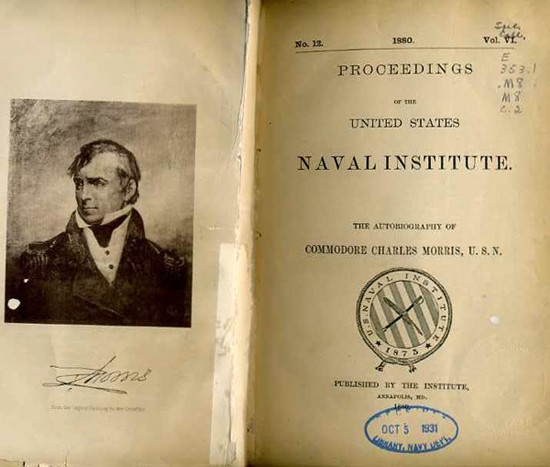
A dozen years later, Morris assumed command of the Charlestown Navy Yard in Boston. The year was 1827. Of this assignment he wrote:
The duties of the yard left me considerable leisure as compared with the duties to which I had been used in the Board of Navy Commissioners In the course of reading Clerks treatise on Naval Tactics, in 1820, I had found occasion to note in the margin a dissent from some of his conclusions. These became so numerous, at last, and many of his errors appeared so important, that I now determined on a more formal notice of them. This again led to the collection and examination of accounts of naval actions that had occurred subsequently to Clerks publication, and finally formed a small volume. This proved to be a very useful occupation, as it led to a careful examination of the advantages and disadvantages of the particular modes of attack and defence under the peculiar circumstances of each fleet or squadron, and the ulterior objects of the respective parties. This latter consideration appears to have been entirely overlooked by Clerk. (2)
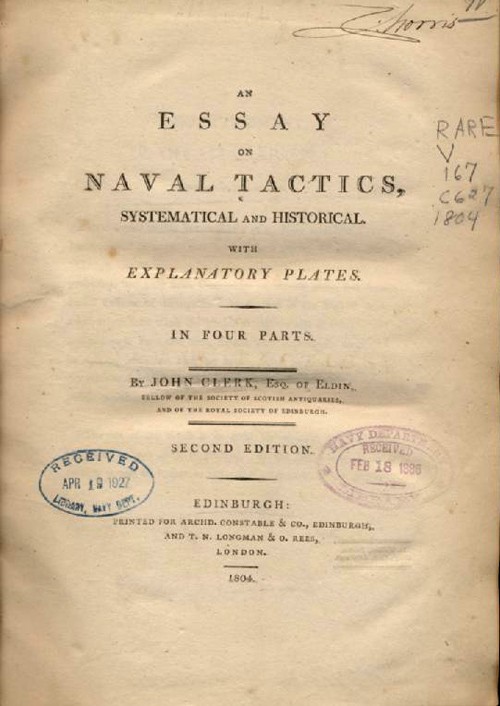
*****************************
Fast-forward 180 years, to 2007. While searching the rare book vault of the Navy Department Library for volumes associated with the family of Commodore John Rodgers I pulled a copy of John Clerks An Essay on Naval Tactics (Edinburgh, 1804) from the stacks.
Clerks Naval Tactics is a seminal British publication on fleet naval tactics. The 1804 edition is a second edition. It is divided into four parts, the first of which, Of the Attack from the Windward, was published in a limited edition for Clerks friends in 1782, and in a larger edition in 1790. The other three parts, The Attack of Fleets from the Leeward, An Historical Sketch of Naval Tactics, and an untitled Part IV analysis of the 1782 engagements of Hood, Rodney and Hughes in the West Indies, were first published as a single volume in 1797. The 1804 edition was the first to bring all four parts together in a single volume.
Clerk admits he is an amateur tactician. He has never been to sea. Yet his intellect brought a science to naval tactics that, with the exception of a few translations of French works on the subject, had yet to emerge from an English printing press. Not every British admiral and post-captain rushed to applaud Clerk; some objected sufficiently to say so in print. That said, not a few senior officers took him seriously. In the Preface to the 1804 edition, Clerk observes that:
Though a superior degree of knowledge in naval affairs be evidently of the utmost consequences to the inhabitants of this island, yet the subject of Naval Tactics has long remained among us in a very rude and uncultivated state. (3)
Opening the copy of Naval Tactics I had pulled from the stacks I found the signature of Charles Morris adorning the upper right corner of the title page, and, looking further, much to my surprise, I found the volume replete with Morris marginal commentary. Further, inscribed in his handwriting above the Preface was the following:
The manuscript notes in this book were principally made in 1822 by C. M. and further study and examination induced him afterwards to form different opinions in several cases, particularly in relation to the best modes of meeting the proposed attacks. (4)
I was awed; in my hands was Morris own copy of Clerks Naval Tactics, the very volume to which he refers in his 1840 autobiography.
**************************
I was well aware of Charles Morris's fame as a fighting naval officer. When the captured frigate Philadelphia was boarded and burned by Stephen Decatur in Tripoli in 1804, Midshipman Morris had been at Decaturs side. As Executive officer on Isaac Hulls Constitution Lieutenant Morris had been seriously wounded while leading the boarding party during Old Ironsides victorious action with the British frigate Guerriere in 1812. My own collection of early naval documents includes invitations to Morris to attend dinners in honor of his gallantry and that of his shipmates during their contest with Guerriere, as well as a letter from citizens of New York presenting him a sword for the same engagement, and his response. But this find was intriguing. What might it yield about Morris understanding of contemporary fleet naval tactics and naval warfare? What might it imply about the post-War of 1812 American naval officer corps appreciation of European fleet tactics?
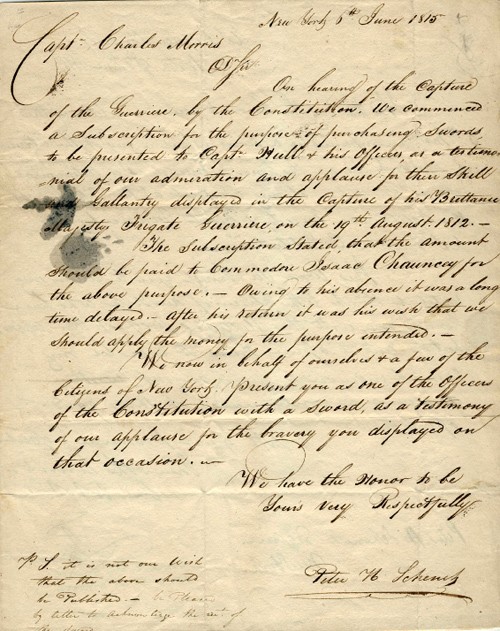
What follows are a series of excerpts from Clerks Naval Tactics and Morris commentary on those excerpts; some marginalia, others one or more full pages in length accompanied with sketches by way of explanation. Many are terse, others are lengthy, and all are cogent. They represent but a small percentage of Morris remarks to be found in this volume, but capture the essence of his thinking.
In his Introduction Clerk notes that the number of British seaman increased dramatically between the 16th and 17th century, an increase that ran counter to his expectations. Morris sought to explain:
The union of the two kingdoms, the elimination of monopolies, the influx of protestant emigrants from other countries, united with other causes to increase commerce, and the number of seamen necessary for carrying it on. (5)
Later in the Introduction Clerk contends, without derogating from the gallant behavior of the Dutch we are bound, from proofs and examples, to believe, that British seamen are, by nature or habit, endured with a peculiar extraordinary character. To which Morris replies:
The English seamen are well acquainted with their profession and rendered hardy by an active commerce and particularly by a{n existing} trade carried out upon a dangerous and tempestuous coast. Their officers are generally skillful & experienced& to these causes the English success over other nations is to be principally attributed. Nations are all {equally} brave alike. (6)
Part I, Of the Attack from Windward, is by far the largest section of Clerks book, consuming 160 of the total 287 pages. In Section II of Part I Clerk compares the effect of shot directed against a ships rigging as opposed to being directed against the hull. He contends the more severe effects result from firing against the rigging. Morris objects:
This supposition is not merely an extreme but an almost improbable case. If shot directed at the rigging may destroy shrouds masts &c, the probability is that many will see no injury at all, as firing directed high, unless they come in immediate contact with something they do no injury. If directed at the hull [they] may also effect the ships rudder wheel &c, or pass through between wind and water, and as shot when thus directed may fall short they will in almost any common weather ricochet and will do material injury either to the hull or rigging. (7)
One of Clerks major concerns is that the French repeatedly courted the leeward position in fleet actions, and that British ships have been disabled repeatedly as they try to press home the attack from windward. To this Clerk asks, Shall we have reason to believe, that the french have adopted, and put into execution, some system, which the British have not discovered, or have not yet profited by the discovery? In answer, Morris has penned:
We may believe that the English have adopted injudicious modes of attack and that the French have had thereby an opportunity of avoiding general actions of which they judiciously availed themselves. (8)
Clerk uses Admiral Byrons attack upon the French fleet at Grenada in 1779 to illustrate the French use of the leeward position to avoid a decisive engagement while retaining the object of their mission, control of Grenada. Morris asks:
Would not any judicious commander follow the same plan with the same object in view? He then adds, In the late war with Great Britain, Sir James Yeo having the protection of Canada for his object, could never be brought to action upon Lake Ontario unless when he had such a superiority of Force as rendered his victory morally certain, because, while he kept the naval superiority doubtful, he rendered Canada as safe as from invasion in that quarter, as it would have been had he obtained the absolute ascendancy. (9)
Clerk presents over 50 engravings in support of his analysis of various fleet actions and presumptions. One such engraving (below) illustrates Clerks perception of fleet movements during Admiral Rodney's engagement with the French fleet of Martinico on 17 April 1780. Morris takes issue with the positions as postulated by Clerk.
Almost all the figures are incorrectly drawn. The van of the English fleet must have got into position before they were abreast of the van of the French. The Sandwich, Rodneys ship after beating three ships out of the line engaged the French admiral who had been brought to windward of Rodney. The French rear retreated & was pursued by the English rear so far that they did not rejoin Rodney for two days! Rodney was exceedingly dissatisfied with the conduct of many of his captains and made an entire new arrangement of his line of battle in consequence. (10)
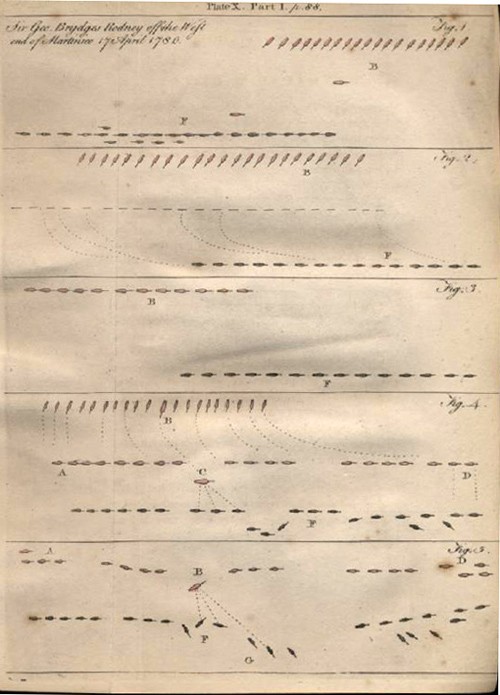
In evaluating Admiral Keppels attack on the French Fleet off Ushant, 27 July 1778, Clerk, assuming a regularity in the rate of fire and speed of each ship, uses diagrams and calculations to determine the frequency to which ships of opposing lines would be exposed to broadsides. Morris is not satisfied with Clerks numbers and does his own calculations. He offers the following detailed analysis of Clerks evaluation.
[Clerks] computations being grounded upon the assumption that the ships are 880 feet in the line and that they drove past each other in the opposite lines & directions at a rate of 880 feet in a minute, if we further suppose that broadsides from each may be repeated in four minutes, we shall have the following results. The leading ships in each line may receive one broadside from every ship in the opposite line& the 5th, 9th, 13th, 17th, 21st,& 25th would each receive a broadside from all the ships. The intermediate ships between the 1st, 5th, 9th,& c in both lines would not receive any broadside provided it took just four minutes to reload the guns & that each ship sailed just 880 feet in one minute. The number of ships in the line divided by four would shew the number of broadsides less one each ship would discharge which in the assumed case for the English and French fleets would be eight. It is by no means probable that such regularity will be preserved as to draw all the fire on alternate ship as above, but the van will always be exposed to the whole number and the remaining broadsides of the fleet will probably fall unequally upon the others which in (a) large fleet might entirely disable some of them particularly if the lines passed near each other. (11)
In observing the English propensity to attack from the windward, Clerk writes that although the British sailors innate fighting spirit has yet to be exerted with advantage they will not be discouraged. On the other hand, that the enemy may justly be said to have not in that degree, if we consider the habitual desire they have constantly shewn, as well in avoiding, as in refusing to make an attack. Morris replies:
The poor French and Spaniards are called cowards because they improve the advantages offered by the unskilled attacks of the English & because when they had opportunity they declined acting with equal want of skill. (12)
He goes on to note,
France and Spain from the state of their countries could with much more ease replace Ships than Seamen. What use ships are without seamen and experienced officers, the war of the French Revolution demonstrated. (13)
In the Appendix to Part I, Clerk examines Admiral Sir George Pococks indecisive action against a French fleet in the East Indies on 29 April 1758. Using a diagram (below) Clerk explains that it was Pococks intention to steer directly for the lead French ship, the Zodiaque, and that his other ships would each steer for their opposite number in the same way. He goes on to state, In the prosecution of which intention, and while the enemy had way ahead, at the rate, perhaps, of two miles and a half, per hour, the Yarmouth (Pococks flagship) and every other ship of the squadron, of necessity, must have assumed a course forming each of them a curve.
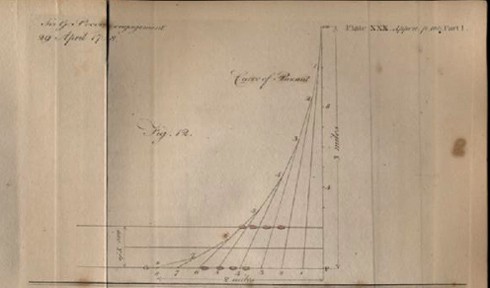
Once again Morris disagrees:
This assumption is absurd, unless we suppose Pocock to have been ignorant of the first principle of chasing which require the chasing ship to hold such a course as should keep the ship chased at the same bearing. A fair presumption appears to be that his intention was to bear up together and each ship chase his opponent which would bring all his fleet in action at the same time and at the same distance and this manoeuvre would not be very difficult to perform. The fleet of [Pocock] would be longer exposed to the fire of [the French], but at a lesser disadvantage than it would have been by a more open angle of course. The gross misconduct of [Pococks] rear, and the neglect of the van in not keeping equally advanced with the Admiral, were the principal causes of the indecisive nature & result of the action. (14)
It is in Morris evaluation of Clerks analysis of Pococks action that his understanding of tactics shines through. Morris takes advantage of the description of Pococks action to determine the relative punishment Pococks fleet would have suffered relative to the French fleet as the former closed to engage the latter. To do so he adds a double page sketch, labeled A, accompanied by an explanation of that drawing (below). Note the similarity between the initial positions of Pococks squadron ABP and the French squadron EFD in Morris drawing, and those same positions in Clerks engraving (see previous illustration, Pococks ships in red).
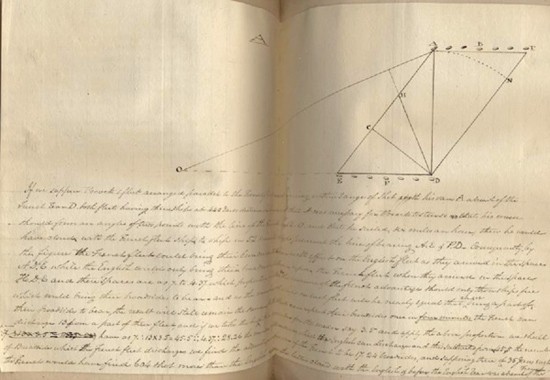
Here is what Morris writes in explanation of his diagram:
If we suppose Pococks fleet arranged parallel to the French fleet and cruising within range of shot with his van A abreast of the French rear D both fleets having their ships at 440 yards distance in line and that it was necessary for Pocock to steer so that his course should form an angle of two points with the line of the French as AO and that he sailed six miles an hour, then he would have closed with the French fleet, ship to ship, in 52 minutes, and preserved the line of bearing AE & PD. Consequently by the figure the French fleet could bring their broadsides to bear with effect on the English fleet as they arrived in the space ADE while the English could only bring their broadsides to bear upon the French fleet when they arrived in the space HDE and there spaces are 7 to 4.37 which proportion would be the measure of the French advantage should only those ships fire which could bring their broadsides to bear, the result will still remain the same. If the fleets can repeat their broadsides once in four minutes the French can discharge 13 from a part of the fleet, and if we take the half their number for the mean, say 3.5, and apply the above proportion we shall have as 7:13x3.5 = 45.5 :: 4.37:28.26 [editors note: Morris is a little off, I calculate closer to 28.405!] the number of broadsides which the English can discharge and this subtracted from 45.5, the number of broadsides which the French fleet discharges we find the advantage in favor of the French to be 17.24 broadsides, and supposing these of 35 guns each the French would have fired 604 shot more than the English before the latter closed with the English and before the English rear was abreast the French. (15)
Further, on the verso of the previous page, referring to his inked sketch he writes:
It is sufficiently evident from an examination of the opposite diagram, A, that the van of the English or attacking fleet would be exposed to a fire much more severe than any it would return, and much greater than the rear. On the contrary it appears that the rear of the French fleet would suffer most and particularly the rear ship. These necessary consequences compared to the actual results of Pococks action seem to strengthen the belief that his attack was made in the manner represented in the diagram A. It appears that the four headmost ships of Pococks fleet were rendered incapable of pursuit, and the rear ship of F, or the French, was so much injured as to render it necessary to run her ashore and destroy her shortly after. It is probable also that the other rear ships of the French were considerably injured, but not imparably so. It is also not a very unfair supposition that instead of the French rear and center running to leeward as a manoeuvre which had been preconcerted, and as forming part of a general system, it was caused by the injuries they had sustained and was in a degree unavoidable. It is true that if the English fleet waited until they had reformed their line to leeward before they bore up again to pursue or attack them that the French would then have a repetition of their former advantages, but had the English pursued immediately and been able to sail equally fast, no such advantage could have resulted to the French, and if the superiority of the sailing was in favor of the English they might have renewed the action on equal terms, and compelled the French to general action or such a general chase as they adopted in the subsequent engagement. (16)
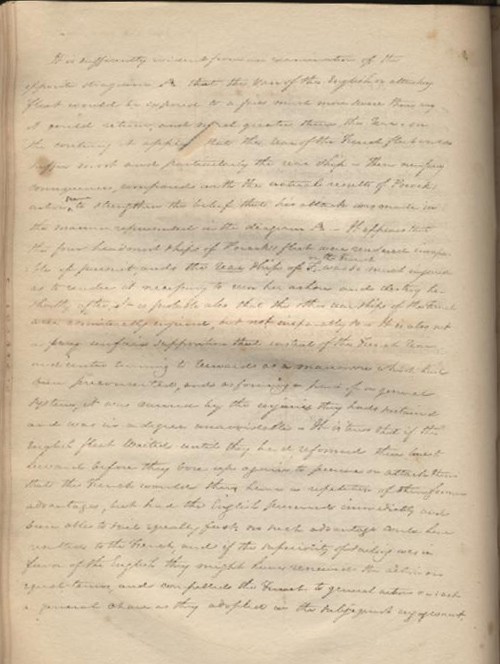
In Part II of Naval Tactics, Clerk examines The Attack of Fleets from the Leeward in which he presses home the advantage of breaking the enemys line to disable and capture the enemys center or rear before the enemy van may be brought to action. Referring to the below illustration, Clerk writes, When the leading ships of the fleet A (fig. 21, Plate VI), shall have fetched the centre of the enemy F, the ship B, which shall attempt the passage will either make her way through the interval which will be given her, and the ship G, with all the ships astern, will be forced to leeward as in fig. 21.; or the ship B, by running aboard of G, and both ships coming to the wind (as per fig. 22.), the whole ships astern of such attack will be stopped and retarded. But, which ever of these ways it shall take place, the line will be cut in twain (as in fig. 23.); the rear will be separated from the van; and the whole ships of the enemy astern, will be forced to leeward (as in fig. 23.) Meanwhile, the van A (Plate VI. Fig. 24.) ranging to windward , and B, the center and the rear A, by this time come up, the rear of the enemy G prevented from getting ahead, and finding it impractical to regain the van F, will prepare to put before the wind, as in fig. 24.
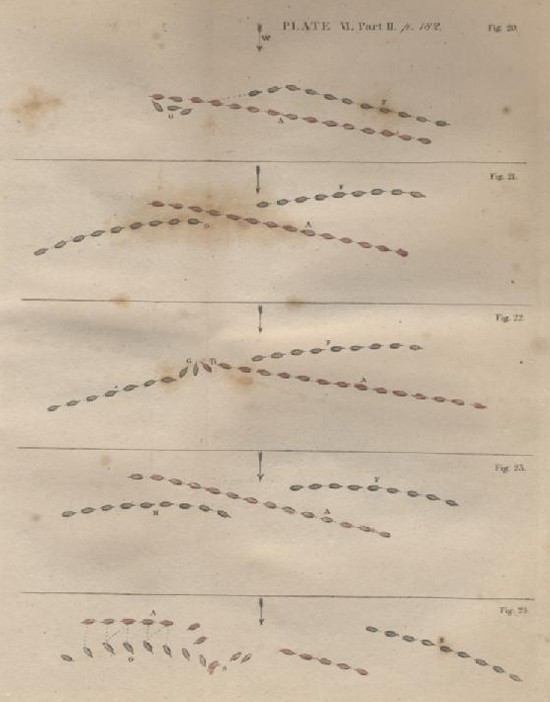
In response, Morris writes:
It does not seem absolutely necessary to admit the consequences which Clerk has inferred in the consideration of this manner of breaking the weather line of F. If we suppose the rear of F to bear up in succession and run down to leeward of B its numbers will be sufficient to render such a manouvre practicable although the advantage would be in favor of B in the same proportion as the relative number of vessels which pass each other. The van of F should also bear up so as to be ready to meet its rear when it shall have passed the rear of B and the extreme van should either crowd sail so as to range themselves on the other line of bearing, or attain a position that would facilitate their closing with the line of B should the latter wear his line together and run parallel to the rear of F which is under his lee for the purpose of keeping the two parts of the fleet separated. Another plan might be adopted by F. His van might wear together as soon as his line was broken, run contrary to their former course and draw out in succession against the ships of B which are near his van. The rear of F in the mean time stand on, bear up in succession and run along to leeward of Bs line till Fs rear ship arrives and bears up, then let all this division wear together & haul their wind on the other tack. The whole of F would thus be engaged with the whole of B separated it is true, and having suffered several disadvantages, but still in a better situation than if they were to pursue the plans suggested for them by Clerk. (17)
In Part III Clerk provides An Historical Sketch of Naval Tactics. He examines three periods; the first, in which oars provide the motive of motion including the battle of Lepanto in 1571; the second, in which sails become the primary source of movement; and the third, which includes the engagements which he has analyzed in the previous parts of his work starting with Admiral Matthews, 1744, through Pocock, 1758. On an early page in this section, Morris pens:
Mr. Clerk is wrong in supposing himself able to give correct plans of any one of these actions. He has indeed given a general idea of the disposition of the respective fleets and he has furnished in each instance such detailed information as is necessary to form correct opinions of the propriety of general and particular movements as to ascertain the causes and particular effects.
The fault is not attributable to him, but to the want of such detailed information as is necessary from persons who were actually engaged in the actions themselves. The official accounts of battles contain little more than the results, and a notice of some of the general manouvres which were adopted by the respective fleets. It is not probable that such descriptions of actions will often be furnished as shall be sufficient to form correct plans. For this purpose it would be requisite that the number, in each fleet, their distance in line, their course, velocity of motion, power of increasing or diminishing their motion, particular arrangement, and object, the state of the weather & sea, the relative positions of the two fleets, & their distance, would be necessary to be known, at the moment any manouvre was commenced, and during its continuance, to judge of its propriety and most of these things most be noted at the moment, for it is not in sea engagements as in those upon the land where many objects remain stationary and can be subsequently examined. We cannot therefore expect to ever possess correct plans of any engagement, but it is to be hoped, that should the American fleet ever meet others in battle, their commanders will endeavor to furnish as many correct data as possible, for the benefit of those who may come after them since it cannot be doubted, that plans even tolerably correct might be advantageously studied. (18)
In examining actions from the third historical period as defined by Clerk above, the author decries the way in which Admiral Matthews brought his fleet into action against the Spaniards in 1744. Attacking from windward the leading three ships in Matthews van were exposed to the fire of the entire Spanish line and were so disabled that he was unable to pursue the enemy who retired unvanquished. Morris, noting that Matthews rear failed to support him, writes:
If the Admirals fleet was arranged as shown in the plans, it is not easy to see how he could make his approach different from what he did except by {sending} down his rear, which did not seem disposed to obey his orders or by bearing up in succession and running down in a line at right angles as Nelson did at Trafalgar. It appears tolerably evident that had Matthews been properly supported even in his rear, the rear of the combined fleets would have been captured and had his whole fleet bore up with him and engaged as close as the Berwick a very decisive action would have taken place, and in all probability a signal victory to the English. (19)
With Part IV, Clerk closes his Essay on Naval Tactics by once again returning to the 1782 battles of Sir Samuel Hood and Sir George Rodney in the West Indies, and Sir Edward Hughes actions with M. Suffrein in the Indian Ocean. He applauds the unusual tactics and skill displayed by Hood during his action with Count de Grasse off St. Christopher in February of 1782. In that action Hood saved the island from a French assault by bringing his smaller fleet to anchor between the island and the French fleet and thwarting repeated attacks by de Grasse with little loss. Of this battle Morris writes:
That the conduct of Sir Samuel Hood in this affair was bold and evinced a mind of no common order is very apparent, but that his conduct was deserving all the praise Clerk has bestowed upon it seems at least questionable. The conduct of De Grasse certainly reflects no credit upon him as a commander. He abandoned a situation as untenable against an inferior force, which he was not able to carry, when occupied by the same force against which he feared to attempt its defence. The proposed plan of attack by Hood, was a good one and much preferable to that adopted by De Grasse, since it was intended to bring the whole of his fleet against a part of his enemys.
But after Sir Samuel had anchored his fleet, what would have been his chance of sustaining an attack had De Grasse possessed the genius of Nelson, and adopted a mode of attack similar to the attack at Aboukir? - which it was perfectly in his power to have done. But fortunately for Sir Samuel, he had not a Nelson to contend with. In fact, the world has rarely seem the same nautical information, quick conception, prompt decision, facility of resource and daring intrepidity united in any other individual, as Nelson possessed. (20)
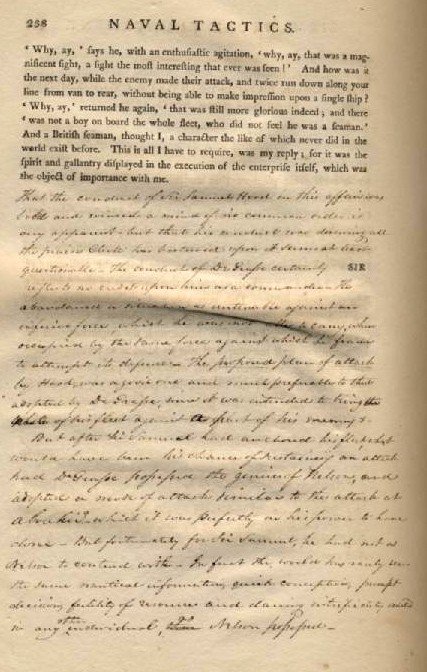
The victorious fleet actions of 1782 provided Clerk with much satisfaction. Returning to his Preface, these were his words:
Since the appearance of the following system in print, about twenty-two years ago, it has been a source of the greatest satisfaction to me to observe a total change in the mode of conducting engagements with great fleets, or on the part of our gallant British Admirals. The spirit, perseverance, and superior skill of our seamen, uniformly displayed in close engagements in the case of single ships, but which from the dexterous maneuvers of the enemy, could not formerly be brought into proper effect, on account of a total neglect of the study of Naval Tactics, have at last been exhibited also in the case of great battles with numerous fleets, in a manner which has led to naval victories that must ever appear with the greatest luster in the British annals. (21)
I will not disguise the satisfaction, and even the consolation I have, in thinking (in which I have been joined by many) that I have been the means of introducing a system of Tactics, which has given to the British Fleets that evident superiority over their enemies, to which the gallantry and skill of the officers and men, and the construction and force of ships, always entitled them. (22)
Of these 1782 battles, it is Sir George Rodneys action that is Clerks greatest source of pride, and perhaps his greatest disappointment, too. Clerk writes that he had, through a third person, brought to Rodneys attention his theory of cutting the enemys line and attacking the enemys rear. Rodney cut the French line in his successful action with the French at the Battle of the Saints in April 1782. While Rodney subsequently denied Clerks influence and the details of that action remain controversial to this day, Clerk never lost faith that it was his tactic that brought Rodney victory.
*******************************
The passages and arguments penned by Charles Morris in his copy of Clerks An Essay on Naval Tactics are many. Those mentioned in this essay are but a small fraction. It was my object to study Morris commentary with the goal of discovering his understanding of contemporary fleet tactics, his knowledge of 18th century naval warfare, and to determine if his understanding of these subjects reflected the general knowledge of the typical post-War of 1812 American naval officer.
While I have satisfied myself that Morris did indeed have an fine understanding of both fleet tactics and contemporary naval warfare, what about the third quest, the extension of Morris understanding of those subjects to the American naval officer corps as a whole?
My search yielded no definitive answer, although Morris autobiographical comments quoted earlier in this essay relative to the unsuccessful efforts of Bainbridge to exercise his squadron in a fleet-like manner in 1815, lead one to conclude that few officers possessed proficiency in such sailing. That lack of proficiency, however, should come as no surprise. The ships of the greatly outnumbered blue-water American navy of the War of 1812 had sailed and fought principally as single units. On lakes Erie, Champlain and Ontario the considerable experience of Perry, Macdonough and Chauncey did result in organized squadrons engaging similar British groups, but these squadrons were composed of ships considerably smaller than their blue-ocean counterparts, manned by seamen who had only limited opportunity to practice multi-ship maneuvers and who were far more proficient in gunnery than naval tactics. Clerks fleet naval tactics appear nowhere in their engagements.
While many American naval officers, Perry, Macdonough and Chauncey included, likely observed British leviathans sailing in line-of-battle in the Mediterranean during the first decade of the 19th century, the need for a United States officer corps proficient in fleet sailing must have appeared remote. The immediate post-war navy included only a pair of 74 gun ships; the remaining vessels were frigates or smaller. Indeed nearly a century would pass before the United States Navy would produce a corps of officers proficient in fighting and sailing as a fleet. Those officers were the product of the new steel navys combat experience during the Spanish-American war and months of round-the-world steaming with the Great White Fleet from December 1907 to February 1909.
Yet where proficiency may not have been mandatory should not the post-war officer corps have been students of the tactics of its European rivals? Morris apparently thought so, and there is strong evidence that his understanding of the tactics of European naval warfare may have been well above the norm of the post-war officer corps. At the close of the War of 1812 President Madison signed into law an act creating the Board of Naval Commissioners. The Board was to consist of three post-captains, appointed by the president and confirmed by the Senate. They would work with the office of the Secretary of the Navy and were to discharge all the ministerial duties of the said office, relative to the procurement of naval stores and materials, and the construction, armament, equipment, and employment, of vessels of war, as well as all other matters connected with the naval establishment of the United States. (23) In short they would establish the operational and administrative norms for the post-war Navy.
Navy Secretary Crowninshield asked the senior active officer, Commodore John Rodgers, to nominate officers to serve on the Board. After much thought Rodgers recommended two trios to the Secretary as those most suitable: Bainbridge, Hull and Morris, or Hull, Porter and Morris. The Secretary nominated the latter group to the president, having substituted Rodgers for Morris. The Senate confirmed them on 16 February 1815. Despite his initial rejection, with the exception of John Rodgers, Morris eventually served more years on the Board of Naval Commissioners (fifteen between 1823 and 1841, the last two as its president) than any other officer.
Of Rodgers 1815 nominations to the Board of Naval Commissioners only one was not an officer commissioned at the birth of the Department of the Navy in 1798. That man was Charles Morris. Morris had entered the Navy as an acting midshipman in 1799, and of the 358 midshipmen listed in Charles W. Goldsboroughs An Original and Correct List of the United States Navy published in 1800 he ranked a lowly 321st. (24)
In recommending Morris to the Secretary, Rodgers wrote that he was a man of
strong discriminating mind, of considerable science, and unites perhaps as much if not more, theoretical and practical knowledge than any man of his age in the service. (25)
Charles Morris rise in rank and respect between 1800 and 1815 was extraordinary. No less extraordinary is the knowledge and understanding of European naval warfare demonstrated by Morris in the extensive commentary and analytical analysis penned by him in his copy of Clerks Naval Tactics. One may conclude, as I have, that his understanding of that subject far exceeded that of his peers. He was indeed a man of letters and numbers.
FINIS
Authors comments: The transcription of Charles Morris marginal commentary is hampered by the presumably thoughtful initiative of a previous librarian who chose to have Morris copy of Clerks Naval Tactics trimmed and rebound sometime during the previous two centuries. As a result Morris comments are occasionally trimmed leaving word fragments that require interpretation. For the most part I have avoided referencing those marginal comments where ambiguity renders a safe translation precarious. Still, occasionally Morris words will be found in brackets {} in this essay, indicating the authors best judgement of the word that a specific fragment appears to identify.
Words enclosed within [] have been inserted by the author.
Finally, the spelling used by both Clerk and Morris is repeated in this essay just as found.
Notes:
Abbreviations:
Clerk. Clerk, John. An Essay on Naval Tactics (Edinburgh, 1804). Charles Morris copy. Navy Department Library, Naval Historical Center, Washington Navy Yard, D.C.
Goldsborough. Goldsborough, Charles W., An Original and Correct List of the United States Navy. City of Washington, November, 1800.
Paullin. Paullin, Charles Oscar. Paullins History of Naval Administration 1775-1911. Annapolis, MD: U. S. Naval Institute, 1968.
Soley. The Autobiography of Commodore Charles Morris. Edited by Professor J. R. Soley, U. S. Naval Academy. Boston: A. Williams& Co., Published for the Naval Institute, Annapolis, MD, 1880.
(1) Soley, p. 75
(2) Ibid, pp. 99-100. An intriguing subject raised by this quote is the small volume mentioned by Morris. The author is unaware of its whereabouts or even if it still exists.
(3) Clerk, p. (i)
(4) Ibid, p. (i)
(5) Ibid, p. 12
(6) Ibid, p. 14
(7) Ibid, p. 26
(8) Ibid, p. 39
(9) Ibid, p. 61
(10) Ibid, p. 82
(11) Ibid, p. 106
(12) Ibid, p. 120
(13) Ibid, p. 121
(14) Ibid, p. 157
(15) Ibid, tipped in following p. 132. This tipped-in sheet was originally pasted to the gutter of plate XXX following page 165. The paste residue marks are still visible. At some time later the sheet may have come loose and subsequently was incorrectly tipped in, perhaps unknowingly, following page 132.
(16) Ibid, verso of p. 165
(17) Ibid, plate VI, Part II, opposite p. 182
(18) Ibid, p. 200
(19) Ibid, p. 220
(20) Ibid, p. 238
(21) Ibid, p. (i)
(22) Ibid, pp. xiv & xv
(23) Paullin, p. 168
(24) Goldsborough, p. 27
(25) Paullin, p.169
References and additional reading material:
Brief Notice of the Late Commodore Charles Morris. The Providence Journal, [Providence, RI] (January 29th 1856): 15pp.
Clerk, John, Esq. of Eldin. An Essay on Naval Tactics, Systematical and Historical. With Explanatory Plates. In Four Parts. Second Edition. Edinburgh, 1804.
Creswell, John. British Admirals of the Eighteenth Century. Tactics in Battle. London and Hamden, CT: Archon Books, 1972.
Hunt, Livingston, U.S.N. An Old-Navy Autobiography. Reprint from The New England Quarterly, Volume IV, Number 2, 1931. (Portland, ME): The Southworth Press, 1931.
McKee, Christopher. A Gentlemanly and Honorable Profession. The Creation of the U.S. Naval Officer Corps, 1794-1815. Annapolis, MD: Naval Institute Press, 1991.
Paullin, Charles Oscar. Paullins History of Naval Administration 1775-1911. U.S. Annapolis, MD: Naval Institute Press, 1968.
(Soley, Professor J. R.) The Autobiography of Commodore Charles Morris. Edited by Professor J. R. Soley, U. S. Naval Academy. Boston: A. Williams & Co., Published for the Naval Institute: Annapolis, MD, 1880.



